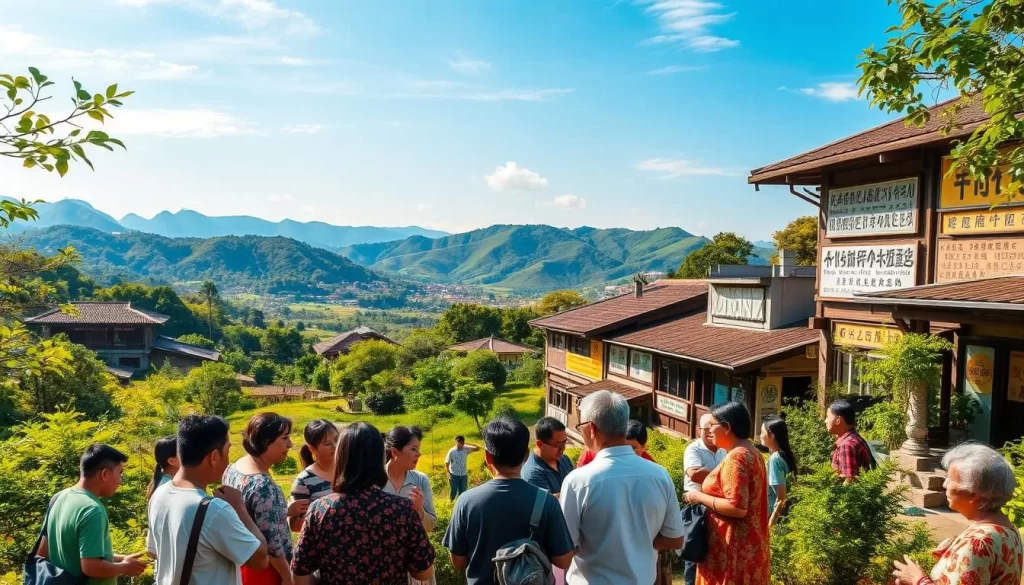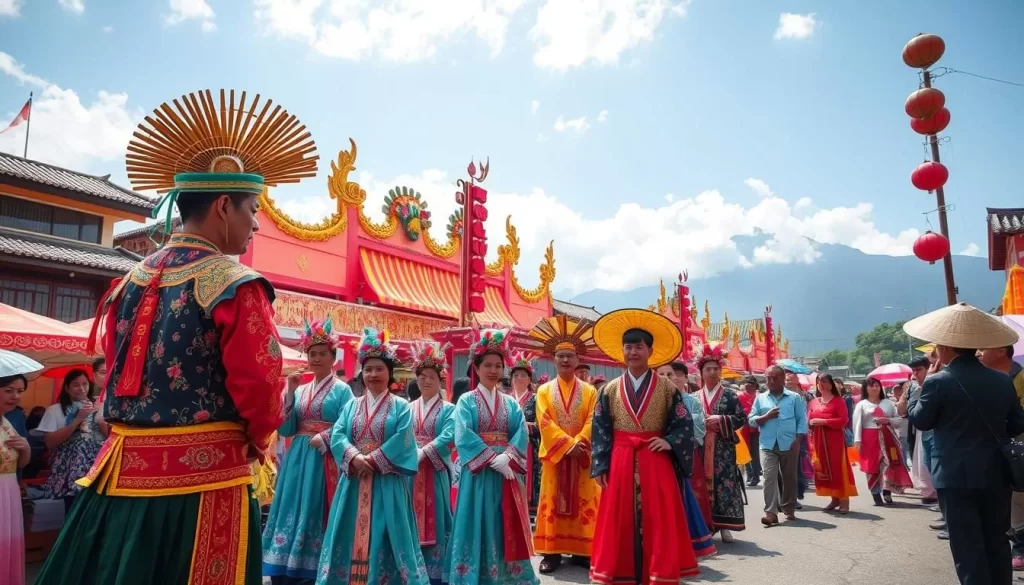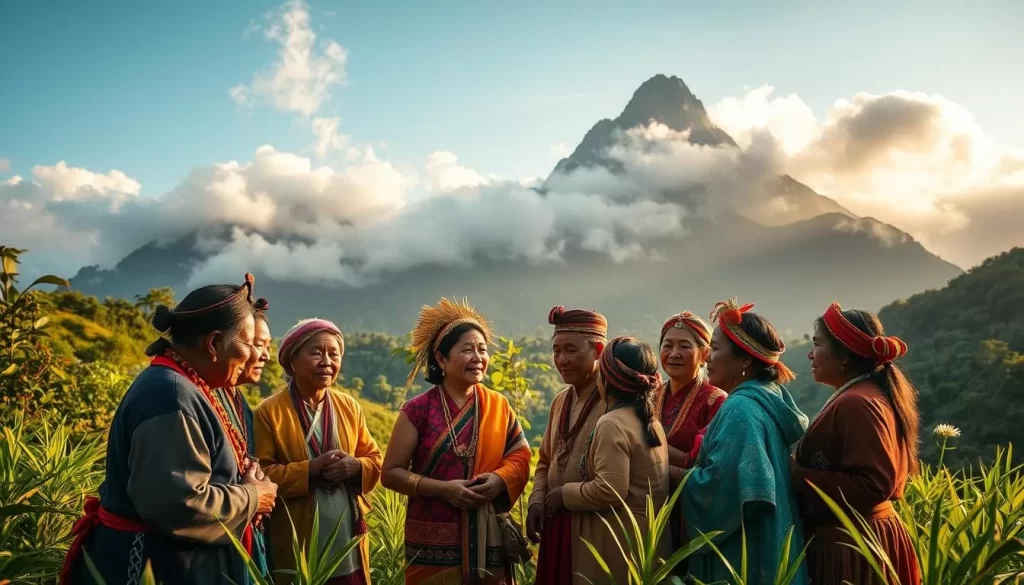As you explore Miaoli County, you’ll discover a unique linguistic landscape that reflects the region’s rich cultural heritage. Located on the beautiful island of Taiwan, Miaoli is known for its diverse language use, shaped by historical migrations and cultural preservation efforts.
The language diversity in this region is remarkable, with a blend of official and local languages. Understanding the languages spoken here will enhance your appreciation of local customs and daily interactions, making your visit or study of the area even more rewarding.
As you delve into the world of language in Miaoli, you’ll uncover the complex relationship between national policies and local practices that have shaped this multilingual environment.
The Linguistic Landscape of Miaoli County
The linguistic landscape of Miaoli County is characterized by a unique blend of languages and dialects. As you explore this region, you’ll discover a rich tapestry of linguistic diversity that reflects the county’s cultural heritage and complex history.
Geographic and Cultural Context of Miaoli
Miaoli County, located in Taiwan, is home to a diverse population comprising various ethnic groups and indigenous peoples. The county’s geographic location and cultural context have contributed to its remarkable linguistic diversity, with four main language groups coexisting: Mandarin Chinese, Hakka, Taiwanese Hokkien, and indigenous Formosan languages.

Overview of Language Diversity in the Region
The linguistic diversity in Miaoli County is notable, with Hakka being particularly prominent, spoken by an estimated 60% of the county’s population as their first language. The various languages in Miaoli interact in complex ways, creating unique patterns of bilingualism and code-switching. You’ll observe that language use often correlates with age demographics and urban-rural divides, influencing the distribution of traditional languages and dialects.
The writing systems used in Miaoli include traditional Chinese characters for Mandarin and increasingly for Hakka, alongside romanization systems for indigenous languages. This diversity creates both challenges and opportunities for cultural expression, education, and community identity, making Miaoli a fascinating case study in Taiwan’s linguistic diversity and languages spoken in the region, including several indigenous languages.
Mandarin Chinese: The Official Language
You might be surprised to learn that Mandarin Chinese, known as (Guóyǔ) in Taiwan, is the cornerstone of official communication in Miaoli County. As the official language, Mandarin Chinese plays a vital role in government, education, and media, ensuring that it remains accessible to everyone, including visitors and new residents.
Status and Usage of Mandarin in Miaoli County
In Miaoli County, Mandarin Chinese is widely used in official contexts, including government services, education, and formal events. You will find that most residents are proficient in Mandarin, using it as a common language for communication across different linguistic and cultural backgrounds. This widespread use of Mandarin facilitates communication and integration within the community.

Taiwanese Mandarin vs. Standard Mandarin
While Taiwanese Mandarin and Standard Mandarin are mutually intelligible, there are distinct differences. You’ll notice that Taiwanese Mandarin spoken in Miaoli County incorporates vocabulary from local dialects like Hakka and Hokkien, creating a unique flavor. Pronunciation differences include less distinction between certain consonants, and tonal patterns tend to be less pronounced. Additionally, Taiwanese Mandarin has adopted Japanese loanwords due to historical influences, making it distinct from the Mandarin spoken in Mainland China.
Hakka: The Heart of Miaoli County’s Linguistic Identity

You’ll find that Hakka is not just a language but a cornerstone of Miaoli County’s cultural heritage. The Hakka language is deeply rooted in the history and identity of the Hakka people, who have maintained their distinct traditions and customs throughout the centuries.
Historical Presence of Hakka People in Miaoli
The Hakka people have a significant historical presence in Miaoli County, dating back to their migrations from other parts of China. This migration has contributed to the rich cultural tapestry of the region, with the Hakka language playing a crucial role in preserving their heritage.
Distinctive Features of Miaoli Hakka Dialect
The Miaoli Hakka dialect is characterized by its unique phonology and vocabulary, distinguishing it from other Hakka dialects spoken in different regions. This distinctiveness is a source of pride for the local Hakka community, reflecting their unique cultural identity.
Cultural Significance of Hakka Language in Local Communities
The Hakka language holds immense cultural significance in local communities, serving as a powerful marker of cultural identity. Here are a few ways it impacts the community:
- Traditional Hakka folk songs, proverbs, and stories continue to be performed at cultural events, preserving the community’s cultural heritage.
- The language is crucial in Hakka religious practices and ceremonies, with certain prayers and blessings preserved in their original Hakka expressions.
- Hakka is closely associated with traditional cuisine, with many dishes maintaining their Hakka names.
- Community gatherings and family celebrations often feature the Hakka language, creating spaces where its use is normalized and valued.
The importance of the Hakka language in Miaoli County cannot be overstated, as it represents a vital connection to the community’s history and cultural roots.
Taiwanese Hokkien in Miaoli County
As you explore Miaoli County, you’ll discover the significant role Taiwanese Hokkien plays in the local linguistic landscape. Despite Mandarin being the official language, Taiwanese Hokkien remains a very common language used in everyday life.
Prevalence and Usage Patterns
Taiwanese Hokkien is widely spoken in Miaoli County, often used in informal settings and among locals. You will find that it is a vital part of the communication in daily activities, markets, and community gatherings.
- In many households, Taiwanese Hokkien is the primary language used for family conversations.
- It’s also commonly used in local businesses and markets for bargaining and transactions.
Interaction Between Hokkien and Other Local Languages
The interaction between Taiwanese Hokkien and other local languages, such as Hakka, has resulted in interesting linguistic phenomena. You will observe:
- Code-switching between Hokkien and Hakka among bilingual speakers.
- Borrowings and hybrid expressions that are unique to the region.
- Influence of Hokkien on local Hakka dialects and vice versa, creating distinctive variants.
The complex interplay between Taiwanese Hokkien, Hakka, and Mandarin has shaped the languages spoken in Miaoli County, making it a fascinating area of study for linguists.
Indigenous Formosan Languages in the Region
As you explore Miaoli County, you’ll discover the rich linguistic diversity that includes indigenous Formosan languages. These languages are an integral part of the region’s cultural heritage.
Atayal and Other Aboriginal Languages in Miaoli
Miaoli County is home to several indigenous languages, including Atayal and Saisiyat. The Atayal language maintains approximately 500-700 speakers in the county, while Saisiyat has fewer than 200 speakers, mostly among the elderly. The UNESCO Atlas of the World’s Languages in Danger classifies both languages as “severely endangered.”
Current Status and Preservation Challenges
The current status of indigenous languages in Miaoli is critical, with many facing extinction due to the prevalence of Mandarin, especially among younger generations. However, efforts are being made to preserve these languages, including the establishment of language nests and immersion programs. Despite these challenges, the loss of these languages would result in the disappearance of unique knowledge systems related to local ecology, traditional medicine, and cultural practices.
| Language | Speakers in Miaoli | Status |
|---|---|---|
| Atayal | 500-700 | Severely Endangered |
| Saisiyat | <200 | Severely Endangered |
| Amis | Around 10,000 | Endangered |

Historical Influences on Miaoli County’s Languages
You can understand the language dynamics in Miaoli County by looking at its history. The county’s linguistic landscape has been shaped by various historical events, including colonial periods and government policies.
Japanese Colonial Period and Its Linguistic Legacy
During the Japanese colonial period, language policies were implemented that had a lasting impact on the linguistic landscape of Miaoli County. Although Japanese was promoted as the official language, local languages continued to be spoken within communities. The legacy of this period can still be seen in the loanwords and linguistic influences that remain in local languages.
Post-1945 Language Policies and Their Impact
After 1945, when Taiwan returned to Chinese control, the Kuomintang government enforced strict Mandarin-only policies, profoundly affecting language use in Miaoli County. During the Martial Law period, speaking Hakka, Hokkien, or indigenous languages in schools or official settings was often prohibited, creating a generation with complex linguistic identities. The education system became a primary tool for promoting Taiwanese Mandarin as the Chinese official language, resulting in many children becoming more fluent in Mandarin than their parents’ native language. Key points to consider include:
- The impact of Mandarin-only policies on local languages.
- The role of the education system in language promotion.
- The revival of interest in local languages after the lifting of Martial Law.

Language Preservation and Revitalization Efforts
As you explore Miaoli County, you’ll discover a rich tapestry of languages that reflect the region’s diverse cultural heritage. Efforts to preserve and revitalize these languages are underway, driven by government initiatives and community-based programs.
Government Initiatives for Language Preservation in Miaoli
The government has launched several initiatives to promote language preservation in Miaoli County. These efforts include language documentation projects, cultural activities, and educational programs aimed at promoting the use of local languages. By supporting these initiatives, the government is helping to ensure the long-term viability of Miaoli’s linguistic diversity.
Community-Based Language Programs and Activities
Community-based programs are also playing a vital role in language preservation and revitalization. You’ll find vibrant community-led language initiatives throughout Miaoli County, including Hakka language classes, conversation groups, and cultural activities. These programs are helping to promote language use among younger generations and foster a sense of community pride. Some notable examples include intergenerational language transmission programs, community radio stations broadcasting in local languages, and cultural festivals featuring performances in Hakka and other local languages spoken in the region.
Navigating Miaoli County’s Multilingual Environment
As you explore Miaoli County, understanding its multilingual environment is crucial for a meaningful experience. The county’s linguistic landscape is characterized by the coexistence of Mandarin Chinese, Hakka, Taiwanese Hokkien, and indigenous Formosan languages.
Essential Phrases for Visitors
Learning a few essential phrases in the local languages can significantly enhance your experience in Miaoli County. For instance, using basic Hakka phrases like “oi” (hello) and “xiè xiè” (thank you) can lead to warmer interactions with locals, especially in rural areas. In business settings, starting with Mandarin is appropriate, but being open to switching to local languages shows respect and flexibility.
Language Etiquette and Cultural Considerations
When interacting with locals, being mindful of language etiquette is crucial. For example, older residents may prefer Hakka or Hokkien, while younger people typically use Mandarin. Language mixing is common in casual conversations, and certain topics like traditional practices or local foods often trigger language switching. Being patient and visually communicative, especially with elderly residents who may have limited Mandarin proficiency, demonstrates cultural sensitivity.
Conclusion: The Future of Languages in Miaoli County
As you explore the linguistic landscape of Miaoli County, you’ll discover a rich tapestry of languages that reflect the region’s cultural heritage. Taiwan’s linguistic diversity is a testament to its multiculturalism and social cohesion. With Mandarin Chinese as the dominant language, Hakka maintains a strong presence in Miaoli County, thanks to community efforts and government support.
The future of languages in Miaoli County looks promising, with a continued emphasis on multilingualism. Recent policy shifts toward language rights offer hope for the vitality of local languages. Technology and tourism are also playing crucial roles in language preservation efforts, creating new opportunities for younger generations to engage with their cultural heritage.
The above is subject to change.
Check back often to TRAVEL.COM for the latest travel tips and deals.






